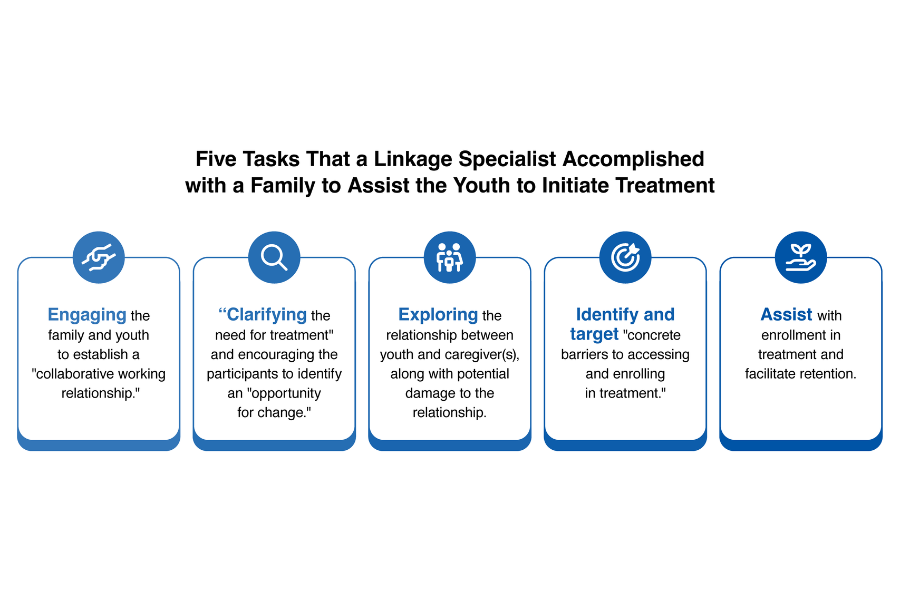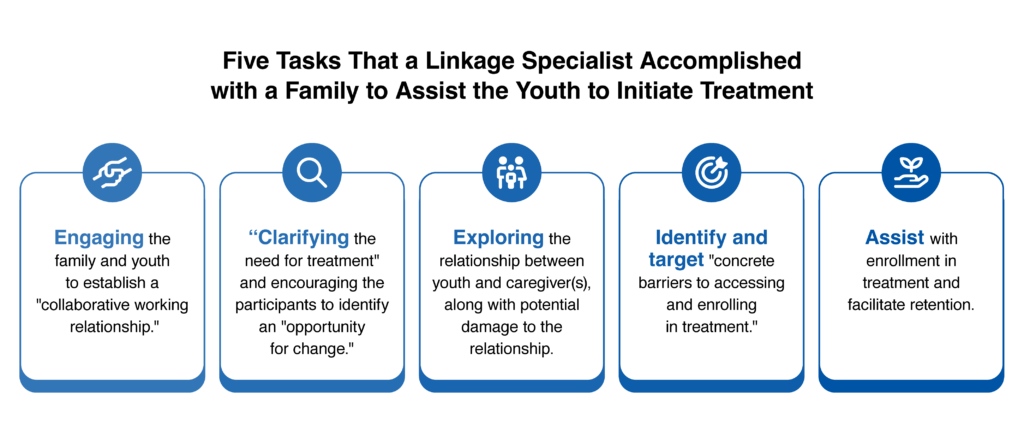
A recent article in Criminal Justice and Behavior highlights results from a new pilot trial program using Family Connect, an intervention designed to link youth involved in the juvenile justice system to appropriate behavioral health resources. Here, we summarize the trial parameters, the authors' key takeaways, and their recommendations for future trials of the Family Connect intervention.
Context of Family Connect
Substance use and substance use disorders (SUD) are more common among justice-involved youth than those in the general population, with 25% to 50% of youth involved in the juvenile justice system reporting an SUD, compared to only 10% in the general population. In addition, approximately 70% of juveniles who are arrested have prior involvement with drugs.
There are several known risk factors for adolescents who use substances, including:
- Developing an SUD;
- Contracting a sexually transmitted disease;
- Greater exposure to violence and early mortality; and
- "Continued involvement with the justice system."
Although some probation agencies across the country do screen incoming youth for behavioral health issues, it has been reported that 50% to 90% of adolescents in the juvenile justice system "do not receive services even after they are identified as in need of treatment."
Probation departments serve as a first point of contact for over half of those entering the juvenile justice system, making them an effective hub for linking youth to service across systems and departments (such as substance use treatment). Yet, research has shown that programs designed to link youth with services and provide appropriate referrals "are not typically integrated into ongoing practice in probation settings." Not only does this impact a justice-involved youth's ability to receive the treatment they need, it also increases their risk of recidivism, particularly for youth from historically marginalized communities.
Family Connect was developed by the authors "to target both system- and family-level barriers via a linkage specialist who, after the PO [probation officer] has screened the youth and identified treatment need(s), will work exclusively to improve engagement, and actively collaborate with treatment agencies and the youth’s PO to enhance referrals and service uptake."
Purpose of Pilot Trial
The pilot trial of the Family Connect intervention was in two separate probation settings in the northeastern region of the United States. The authors stated their goals were to examine "the feasibility and acceptability" of running the program, gather preliminary data on the effectiveness in a probation setting, and report the results.
Their hypothesis was "that, compared with a historical control (care as usual) of youth on probation with substance use treatment needs, Family Connect will increase referrals, intake attendance, and initiation in behavioral health treatment."
Trial Method and Measures
The Family Connect intervention used in the study mirrors the model initially developed, which was created with collaboration from youth, their caregivers, probation officers, and treatment staff. The intervention was designed for delivery to both justice-involved youth and their caregivers, with a variable commitment length based on each family's needs.
The intervention consisted of "five tasks that a linkage specialist accomplished with a family to assist the youth to initiate treatment." Although the first task always had to occur first, the others could be completed in any order at the determination of the linkage specialist.

The linkage specialist met with the family weekly throughout the length of the Family Connect intervention, and "collaborated with the youth’s PO and provider to facilitate communication and information sharing and to bring the family, behavioral health, and justice systems into closer alignment around the youth’s treatment."
Participants for the trial were recruited between December 2015 and May 2017 from probation departments in two counties in the northeastern United States. Youth who were selected had to be on probation, 10 to 17 years of age, and determined to have "probable clinical significance" for substance use based on assessment scores or past documentation. Caregivers had to be the legal guardian of the youth who wished to participate.
The linkage specialists who participated in the trial were licensed behavioral healthcare providers who received training on Family Connect and weekly supervision during the course of the study.
At the end of the trial, half the participants (including their families) were randomly selected to complete an in-depth interview to collect their qualitative assessment of the program. Youth and caregivers were interviewed separately.
Key Findings
Key findings identified by the authors at the conclusion of the pilot study included the following:
- Youth involved in the Family Connect intervention "were 6 times as likely to be referred to behavioral health treatment, compared with youth in the historical control."
- Youth in Family Connect were most often referred to both substance use and mental health treatment; whereas in the historical control group, more youth were referred to mental health treatment only.
- Youth and caregivers approved of having individual and joint meetings with the linkage specialists, and both agreed "that the way the linkage specialist communicated about treatment services was helpful."
- Youth expressed a desire to see the linkage specialist more often than once per week, conveying that greater frequency would be more beneficial.
Ultimately, the authors concluded:
"This family linkage program for youth on probation, Family Connect, shows promise, feasibility, and family acceptability in achieving cross-systems linkage as youth move from the justice system to access treatment in the behavioral health system."
Future Steps
Although this initial pilot study was conducted with a small group of 18 participants, the authors expressed a strong desire to conduct further research on the Family Connect intervention, stating "future research should specifically examine whether Family Connect is effective at reducing racial/ethnic disparities in service referral and uptake."
They also stated it would be beneficial in future research to "analyze and determine patterns related to additional variables, including race, gender, and case type." Finally, using a control group that relied on retrospective data may have introduced bias "historical effects and nonrandomization." Future pilot tests might benefit from a control group that is randomized and more closely aligned with the date range of the study.
To read the full article, visit this link.
* References available upon request.

